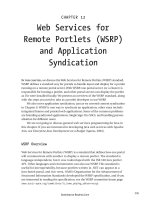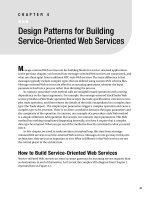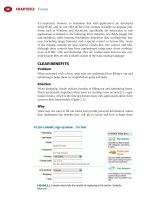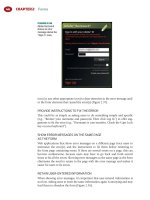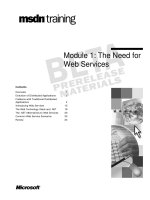Design Patterns for Building Service-Oriented Web Services
Bạn đang xem bản rút gọn của tài liệu. Xem và tải ngay bản đầy đủ của tài liệu tại đây (535.93 KB, 26 trang )
Design Patterns for Building
Service-Oriented Web Services
M
essage-oriented Web services are the building blocks for service-oriented applications.
In the previous chapter, you learned how message-oriented Web services are constructed, and
what sets them apart from traditional RPC-style Web services. The main difference is that
messages typically include complex types that are defined using custom XML schema files.
Message-oriented Web services are effective at executing operations, whereby the input
parameters feed into a process rather than dictating the process.
In contrast, procedure-style method calls are straightforward operations with a strong
dependency on the input arguments. For example, the message-oriented StockTrader Web
service provides a PlaceTrade operation that accepts the trade specifications, executes a com-
plex trade operation, and then returns the details of the trade encapsulated in a complex data
type (the Trade object). The simple input parameters trigger a complex operation and cause a
complex type to be returned. There is no direct correlation between the input parameters and
the complexity of the operation. In contrast, one example of a procedure-style Web method
is a simple arithmetic Add operation that accepts two numeric input parameters. This Web
method has nothing complicated happening internally, nor does it require that a complex
data type be returned. What you get out of the method is directly correlated to what you send
into it.
In this chapter, we need to make another conceptual leap, this time from message-
oriented Web services to service-oriented Web services. Messages do not go away in this new
architecture; they are just as important as ever. What is different is that Web services are not
the central player in the architecture.
How to Build Service-Oriented Web Services
Service-oriented Web services act more as smart gateways for incoming service requests than
as destinations in and of themselves. Let’s revisit the complex SOA diagram from Chapter 1,
reprinted here as Figure 4-1.
57
CHAPTER 4
701xCH04.qxd 7/17/06 1:05 PM Page 57
Figure 4-1. Complex SOA
Notice that Web services are not the ultimate endpoint destinations in this architecture.
Instead, their purpose is to authenticate and authorize incoming service requests, and then to
relay the request details to back-end business components and workflows for processing. This
fact by no means diminishes the importance of their role; it just switches perspectives. Web
services have certain unique properties that make them essential to this architecture:
• Web services process SOAP messages.
• Web services provide accessible (and discoverable) endpoints for service requests.
• Web services (optionally) authenticate and authorize incoming service requests. In
this role they selectively filter incoming service requests and keep out unauthorized
requests. (This feature is technically optional but it is an important available feature
with WSE 3.0, and so is listed here as an essential property).
In contrast, other components in the architecture, such as the business components, do
not have any of these properties. They do not expose publicly accessible endpoints. They
CHAPTER 4
■
DESIGN PATTERNS FOR BUILDING SERVICE-ORIENTED WEB SERVICES58
701xCH04.qxd 7/17/06 1:05 PM Page 58
do not process SOAP requests directly. And they do not have the same ability to filter out
incoming service requests based on security tokens. Note that business components can
implement custom security checks through mechanisms such as code access security (CAS)
and Active Directory checks, but these options are not comparable to the available mecha-
nisms for Web services, which can accept encrypted and signed requests, and which inspect
several aspects of the request directly, not just the identity of the caller.
So we have established that Web services play a unique role in SOA, one where they are an
important support player rather than the ultimate destination endpoint. But what does this
translate to in practical terms, and how is it different from before? The implication is that you
need to build Web services differently to maximize the effectiveness of their role in SOA appli-
cations. This includes the following:
A renewed emphasis on breaking out Web service code-behind into separate class files and
assemblies: This includes abstract IDC files (based on the applicable WSDL document). It
also includes generating a dedicated assembly for encapsulating custom data type defini-
tions (so that common data types may be used across multiple services and components
using a common reference assembly).
Delegation of all business process logic to back-end business components: The Web service
code-behind should be focused exclusively on preprocessing incoming request messages
and then relaying the request details to the appropriate back-end business component.
The Web service code-behind should not handle any business processing directly.
A focus on new kinds of service-oriented components: SOA architecture creates a need for
different kinds of service components that may have no equivalent in other architectures.
For example, SOA applications rely heavily on service agent components, which act as the
middleman between separate Web services and which relay all communications between
them. (You will learn how to build a service agent component in the section “Design and
Build a Service Agent” later in this chapter.)
Be forewarned: some of the material in this chapter may strike you as unusual or
unorthodox and certainly more complex than you are used to seeing with Web services devel-
opment. This is not surprising given that SOA applications are still relatively new. Recall that it
took several years for the n-tier architecture model to become fully formed and to gain wide
acceptance as a standard. SOA will also go through an evolution. Some ideas will gain accept-
ance, while others will fall by the wayside. This chapter quite likely contains some of both, so
read the chapter, absorb the material, and take with you as much or as little as you like.
The primary requirement that SOA imposes on a system is that its business functionality
must be accessible through more than one type of interface and through more than one kind
of transport protocol. Enterprise developers have long understood the need to separate out
business functionality into a dedicated set of components. In Chapter 3, the StockTrader Web
service implemented its business logic directly, based on an IDC file (defined in a separate,
though embedded, class file). This approach is incorrect from an SOA perspective for two
reasons:
CHAPTER 4
■
DESIGN PATTERNS FOR BUILDING SERVICE-ORIENTED WEB SERVICES 59
701xCH04.qxd 7/17/06 1:05 PM Page 59
Web services should not implement business logic directly in their methods: They should
delegate this processing to dedicated business assemblies. This is because you cannot
assume that the business logic will always be accessed through a Web service. What hap-
pens, for example, when a new requirement comes through asking you to implement an
alternate interface that cannot or will not interact with a Web service? You need to have a
separate, ready-to-use assembly for the business logic.
Web services and their associated WSDL documents should not be the original reference
points for interface definitions: Certainly, a WSDL document must conform to an estab-
lished interface definition, but it should not be establishing what that definition is. This
information belongs in a dedicated reference assembly, and should be stored as an inter-
face definition that can be implemented in different kinds of components.
The previous version of the StockTrader Web service is not compatible with SOA because
it prevents common functionality from being accessible via multiple interfaces. To put it in
blunt terms, the StockTrader Web service is simply incompatible with SOA because it is not
abstract enough. What it needs to do instead is to act as a trusted interface to a back-end
StockTrader business component. It cannot directly contain implementation for the Stock-
Trader functions (such as getting quotes and placing trades). Instead, it must delegate this
functionality to a back-end business component and focus on its primary role of authenticat-
ing and authorizing incoming service requests and then relaying these service requests to the
back-end business component. In conjunction to this, the Web service is also responsible for
relaying responses back to the client.
Consider another aspect to this architecture: type definitions. If you separate out
common functionality across multiple components, how do they maintain a common under-
standing of type definitions? For example, how does every component maintain the same
understanding of the Quote and Trade data types? XML Web services and their clients can
share XSD schema information for custom data types via the service’s published WSDL
document. But this is not an efficient way to share type information between a middle-tier
business component and a Web service, especially when the Web service is delegating
requests to the business component. The more efficient approach is to generate a dedicated
assembly that encapsulates the data type definitions as custom classes, and to include a refer-
ence to this assembly from wherever the custom data types are needed.
I have covered several challenging conceptual points, so now let’s move on to code, and
actually build a service-oriented Web service. Figure 4-2 is an architecture (and pseudo-UML
diagram) that provides an alternate architecture for the original StockTrader Web service, one
that will enable it to participate better in a larger SOA. Notice that the type definitions and
interface definitions have been broken out into a separate assembly called StockTraderTypes,
which is referenced by several components in the architecture.
CHAPTER 4
■
DESIGN PATTERNS FOR BUILDING SERVICE-ORIENTED WEB SERVICES60
701xCH04.qxd 7/17/06 1:05 PM Page 60
Figure 4-2. Revised architecture for the StockTrader Web service showing how several components
reference the common StockTraderTypes definition assembly
Based on this UML diagram, there are six steps involved in building a message-oriented
Web service that is compatible with SOA.
Step 1: Create a Dedicated Type Definition Assembly
Create a dedicated definition assembly for interfaces and type definitions. This assembly will
be referenced by any component, service, or application that needs to use the interfaces or
types.
Step 2: Create a Dedicated Business Assembly
Create a dedicated business assembly that implements logic for established interfaces and
type definitions. This business assembly must reference the definition assembly from step 1.
This ensures that the business assembly implements every available method definition.
Once this step is complete, you have the flexibility to build any kind of n-tier solution
using the definition and business assemblies. This chapter focuses on building a service-
oriented application that includes a Web service. But you could just as easily go a different
route and build any kind of n-tier solution using the definition and business assemblies
developed so far.
CHAPTER 4
■
DESIGN PATTERNS FOR BUILDING SERVICE-ORIENTED WEB SERVICES 61
701xCH04.qxd 7/17/06 1:05 PM Page 61
This point underscores the fact that in an SOA, Web services are simply a gateway to a set
of methods and types that are controlled by other assemblies. The Web service itself merely
provides a set of SOAP-enabled endpoints that are accessible over one or more transport
protocols.
Step 3: Create the Web Service Based on the Type Definition
Assembly
In the previous version of the StockTrader Web service, the definition information for the Web
method implementations came from a dedicated IDC file, which provided abstract class defi-
nitions and class-based type definitions. But now this file is no longer needed because you
have a dedicated definition assembly. The new Web service simply needs to import the defini-
tion assembly to have access to the required types and to the required interface.
Step 4: Implement the Business Interface in the Web Service
The Web service needs to import the business assembly so that it can delegate incoming serv-
ice requests. Remember, the current architecture calls for a different level of abstraction,
whereby the Web service itself does not control its interface, its data types, or the processing of
business logic. Instead, it relies on other assemblies for this reference information and for this
processing capability.
By implementing the interface, you ensure that you will not miss any methods because
the project will not compile unless every interface method is implemented in the Web service.
So, the definition assembly provides the interface definition, while the business assembly pro-
vides the processing capability for each method. All incoming Web service requests should be
delegated to the business component, rather than implementing the business logic directly in
the Web service.
The methods in this class file must be decorated with any required reflection attributes,
such as WebMethod and SoapDocumentMethod. You always had to do this, so this is not
new. But there is added importance now because many of these attributes will not be deco-
rated elsewhere. Or if they are, they will not propagate to your class file. For example, the
SoapDocumentMethod attributes are not included in the interface definition assembly
(although the XML serialization attributes are). These attributes are not automatically carried
over to the class file when it implements the definition assembly. As a matter of practice, we
make sure that the interface definition assembly is decorated with the required serialization
attributes, but we leave out attributes that relate to WebService and WebMethod attributes.
This approach is implementation agnostic, meaning that it makes no assumptions about
what kind of class file will implement the interface definition assembly.
■
Note
Reflection attributes provide additional metadata for your code. The .NET runtime uses this meta-
data for executing the code. Class members are said to be decorated with attributes. Reflection attributes
are a powerful tool because they enable the same code listing to be processed in different ways, depending
on how it is decorated. Chapter 3 has a more complete discussion of reflection attributes, and Table 3-1
provides detailed property descriptions for the SoapDocumentMethod attribute.
CHAPTER 4
■
DESIGN PATTERNS FOR BUILDING SERVICE-ORIENTED WEB SERVICES62
701xCH04.qxd 7/17/06 1:05 PM Page 62
Step 5: Generate a Web Service Proxy Class File Based on the
WSDL Document
Proxy class files can still be generated directly from the Web service WSDL document, so this
step does not have to change with a revised architecture in order to still work. However, the
autogenerated proxy class file will not automatically utilize the dedicated definition assembly.
This creates a significant issue because the proxy class file maintains its own type and inter-
face definitions. Your goal is to have a central repository for this information. So in the interest
of type fidelity, you need to modify the autogenerated proxy file to utilize the definition
assembly rather than a separate copy of the same information.
Separate copies can be modified, and there is nothing to stop you from altering a proxy
file so that it can no longer call the Web service it is intended for. This is why it is good to
derive all types and interfaces from a common source.
Step 6: Create a Web Service Client
The Web service client uses the generated proxy class file from step 5 to set a reference to the
new Web service. The client must also reference the type definition assembly from step 1, so
that both the client and the Web service have a common understanding of the data types that
are used by the Web services and its associated business assembly.
Some readers may see a red flag here because this approach creates a very tight coupling
between the client and the Web service due to their mutual dependence on the same refer-
ence assembly. In contrast, it would be much easier to create a loosely coupled client that
autogenerates a proxy file itself, using the Web service WSDL document. This autogenerated
proxy file would include both methods and data types, so it would deviate from the more
abstract approach that we are presenting here—namely, the approach of separating type defi-
nitions and method definitions into a dedicated assembly.
I am not advocating that you should always enforce this level of tight coupling between a
Web service and its client. By definition, Web services are loosely coupled to their clients. This
alternate approach is simply that—an alternate approach that can be implemented if the sce-
nario is appropriate. In some cases, this approach will not even be feasible because the client
may not have access to a dedicated assembly. But this approach may be warranted in other
cases, particularly when you have a sensitive business workflow and you want to prevent any
kind of miscommunication between a service and a client.
So, as with all the material in this book, absorb the information, consider the different
approaches, but then decide which approach is most appropriate for your business
requirements.
Design and Build a Service-Oriented Web Service
This section provides the information that you need to build a message-oriented Web service
for use in an SOA. It is organized along the same six steps presented earlier and provides both
conceptual information and implementation information.
CHAPTER 4
■
DESIGN PATTERNS FOR BUILDING SERVICE-ORIENTED WEB SERVICES 63
701xCH04.qxd 7/17/06 1:05 PM Page 63
Create the Definition Assembly (Step 1)
The definition assembly provides two important sets of information:
• Class definitions for all custom types that are exchanged in the system
• Interface definitions for each operation that the system supports
In this sense it is not unlike the autogenerated IDC file from Chapter 3. Recall that the
type information in this file (StockTraderStub.cs) is autogenerated from an XSD schema file
using the xsd.exe tool. The operations are manually inserted as abstract class methods that
must be overridden by whatever class implements this file.
There are two differences between the definition assembly and the IDC file:
The operations are documented as interfaces rather than abstract class methods. This is
because a given class can only derive from one other class at a time. Web service classes,
for example, must derive either directly or indirectly from the System.Web.Services.
WebService class. The Web service class cannot implement an additional interface
unless it is provided as an invariant interface.
The definition assembly does not include Web service and SOAP-related attribute decora-
tions. This is because it will be referenced from a variety of different assemblies, some of
which have nothing to do with Web services. However, the definition assembly can still
include XML serialization attributes.
Figure 4-3 shows a UML class diagram for the definition assembly. Notice the following
two important points:
1. The type definitions are encapsulated in dedicated classes (e.g., Quote).
2. The method definitions are contained within an interface class called IStockTrader.
It is possible for a client project to reference the StockTraderTypes assembly solely for the
purpose of accessing the custom data type definitions. The client does not need to implement
the interface class, just because it is included in the assembly. But of course if they do, they
will be required to implement every member of the interface.
To create the definition assembly, start by creating a new Class Library project in
Visual Studio 2005 called StockTraderTypes, and add to it a single class file also called
StockTraderTypes.
Listing 4-1 shows high-level pseudocode for the StockTraderTypes definition assembly.
Listing 4-1. Pseudocode Listing for the StockTraderTypes Definition Assembly
namespace StockTraderTypes
{
public interface IStockTrader {}
public class Quote {}
public class Trade {}
public class Trades {}
public enum TradeStatus {}
public enum TradeTypes {}
}
CHAPTER 4
■
DESIGN PATTERNS FOR BUILDING SERVICE-ORIENTED WEB SERVICES64
701xCH04.qxd 7/17/06 1:05 PM Page 64
Figure 4-3. UML class diagram for the StockTraderTypes definition assembly
Listing 4-2 presents a more detailed code listing, excluding XML serialization attributes.
These attributes are important because they directly relate the code elements to XML ele-
ments in the associated XSD schema (which is assigned to a qualified namespace at http://
www.bluestonepartners.com/schemas/StockTrader/).
Listing 4-2. Detailed Code Listing for the StockTraderTypes Definition Assembly
using System;
using System.Xml.Serialization;
namespace StockTraderTypes
{
public interface IStockTrader
{
Quote RequestQuote(string Symbol);
CHAPTER 4
■
DESIGN PATTERNS FOR BUILDING SERVICE-ORIENTED WEB SERVICES 65
701xCH04.qxd 7/17/06 1:05 PM Page 65
Trade PlaceTrade(string Account, string Symbol, int Shares,
➥
System.Double Price, TradeType tradeType);
Trade RequestTradeDetails(string Account, string TradeID);
Trades RequestAllTradesSummary(string Account);
}
public class Quote
{
public string Symbol;
public string Company; // Additional type members not shown
}
public class Trade
{
public string TradeID;
public string Symbol; // Additional type members not shown
}
public class Trades
{
public string Account;
public Trade[] Bids;
public Trade[] Asks;
}
public enum TradeStatus
{
Ordered,
Filled, // Additional type members not shown
}
public enum TradeType
{
Bid,
Ask
}
}
This is all the work that is required to create a definition assembly that can be reused
across other components, services, and applications.
Create the Business Assembly (Step 2)
The business assembly implements the IStockTrader interface that is defined in the Stock-
TraderTypes definition assembly. This logic was previously implemented directly in the Web
service class file. But this design is very limiting because it isolates the business logic inside a
CHAPTER 4
■
DESIGN PATTERNS FOR BUILDING SERVICE-ORIENTED WEB SERVICES66
701xCH04.qxd 7/17/06 1:05 PM Page 66
